Peugeot 301 2017 Owner's Manual
Manufacturer: PEUGEOT, Model Year: 2017, Model line: 301, Model: Peugeot 301 2017Pages: 306, PDF Size: 9.87 MB
Page 151 of 306
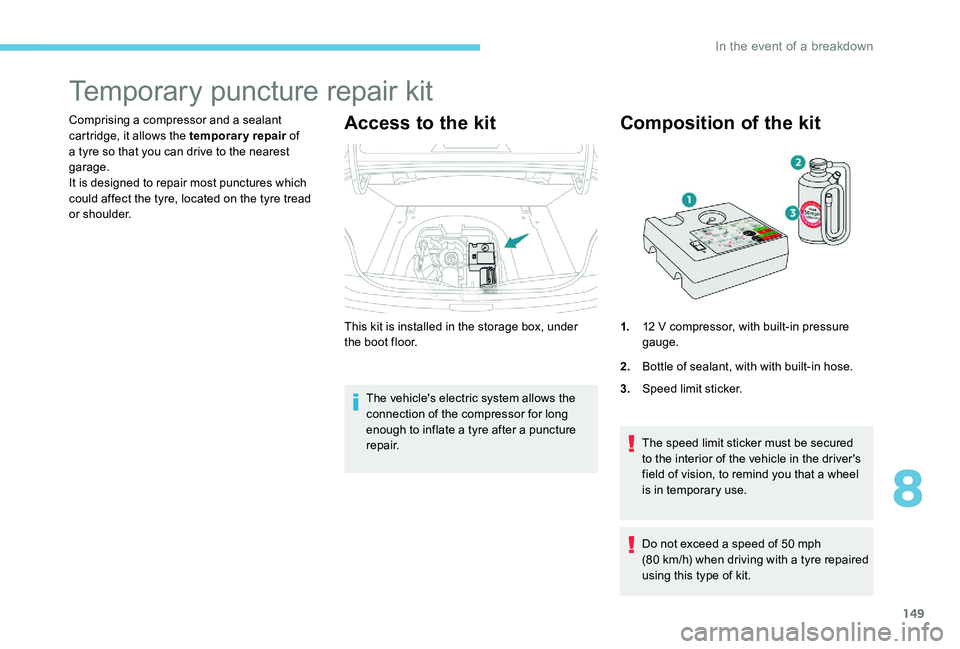
149
Temporary puncture repair kit
Comprising a compressor and a sealant
cartridge, it allows the temporary repair of
a tyre so that you can drive to the nearest
garage.
It is designed to repair most punctures which
could affect the tyre, located on the tyre tread
or shoulder.Access to the kit
The vehicle's electric system allows the
connection of the compressor for long
enough to inflate a tyre after a puncture
repair.
This kit is installed in the storage box, under
the boot floor.
Composition of the kit
Do not exceed a speed of 50 mph
(80 km/h) when driving with a tyre repaired
using this type of kit.
1.
12 V compressor, with built-in pressure
gauge.
2. Bottle of sealant, with with built-in hose.
3. Speed limit sticker.
The speed limit sticker must be secured
to the interior of the vehicle in the driver's
field of vision, to remind you that a wheel
is in temporary use.
8
In the event of a breakdown
Page 152 of 306

150
Repair procedure
F Uncoil the pipe stowed under the compressor.
F
S
witch off the ignition.
F
S
ecure the speed limit sticker inside the
vehicle.
Avoid removing any foreign bodies which
have penetrated into the tyre.
F
C
onnect the pipe from the compressor to
the bottle of sealant. F
R
emove the valve cap from the tyre to be
repaired, and place it in a clean area.
F
T
urn the sealant bottle and secure it in the
cut-out provided on the compressor.
F
C
onnect the hose from the bottle of sealant
to the valve of the tyre to be repaired and
tighten firmly.
In the event of a breakdown
Page 153 of 306
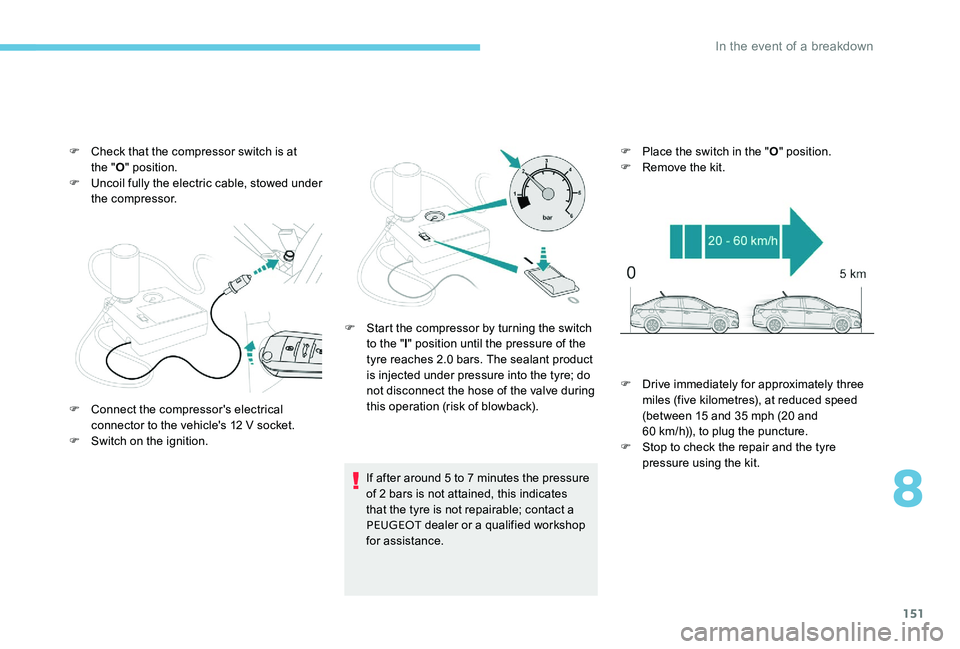
151
F Check that the compressor switch is at the " O" position.
F
U
ncoil fully the electric cable, stowed under
the compressor.
If after around 5 to 7 minutes the pressure
of 2 bars is not attained, this indicates
that the tyre is not repairable; contact a
PEUGEOT dealer or a qualified workshop
for assistance. F
P lace the switch in the "
O" position.
F R emove the kit.
F
C
onnect the compressor's electrical
connector to the vehicle's 12 V socket.
F
S
witch on the ignition. F
D
rive immediately for approximately three
miles (five kilometres), at reduced speed
(between 15 and 35 mph (20 and
60 km/h)), to plug the puncture.
F
S
top to check the repair and the tyre
pressure using the kit.
F
S
tart the compressor by turning the switch
to the " l" position until the pressure of the
tyre reaches 2.0 bars. The sealant product
is injected under pressure into the tyre; do
not disconnect the hose of the valve during
this operation (risk of blowback).
8
In the event of a breakdown
Page 154 of 306
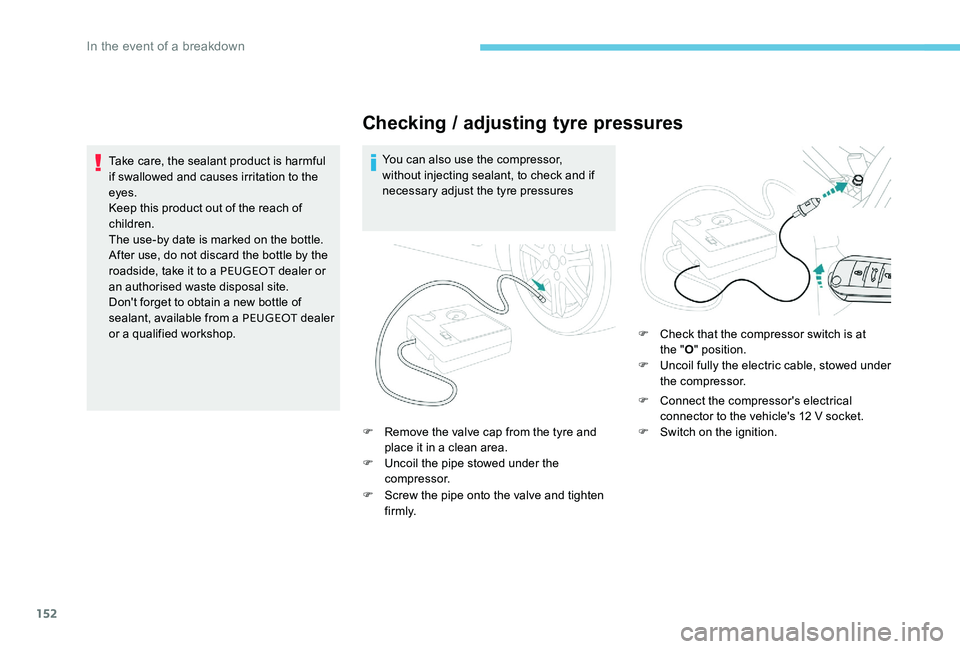
152
Checking / adjusting tyre pressures
You can also use the compressor,
without injecting sealant, to check and if
necessary adjust the tyre pressures
F
R
emove the valve cap from the tyre and
place it in a clean area.
F
U
ncoil the pipe stowed under the
compressor.
F
S
crew the pipe onto the valve and tighten
f i r m l y. F
C
heck that the compressor switch is at
the " O" position.
F
U
ncoil fully the electric cable, stowed under
the compressor.
F
C
onnect the compressor's electrical
connector to the vehicle's 12 V socket.
F
S
witch on the ignition.
Take care, the sealant product is harmful
if swallowed and causes irritation to the
eyes.
Keep this product out of the reach of
children.
The use-by date is marked on the bottle.
After use, do not discard the bottle by the
roadside, take it to a PEUGEOT
dealer or
an authorised waste disposal site.
Don't forget to obtain a new bottle of
sealant, available from a PEUGEOT dealer
or a qualified workshop.
In the event of a breakdown
Page 155 of 306
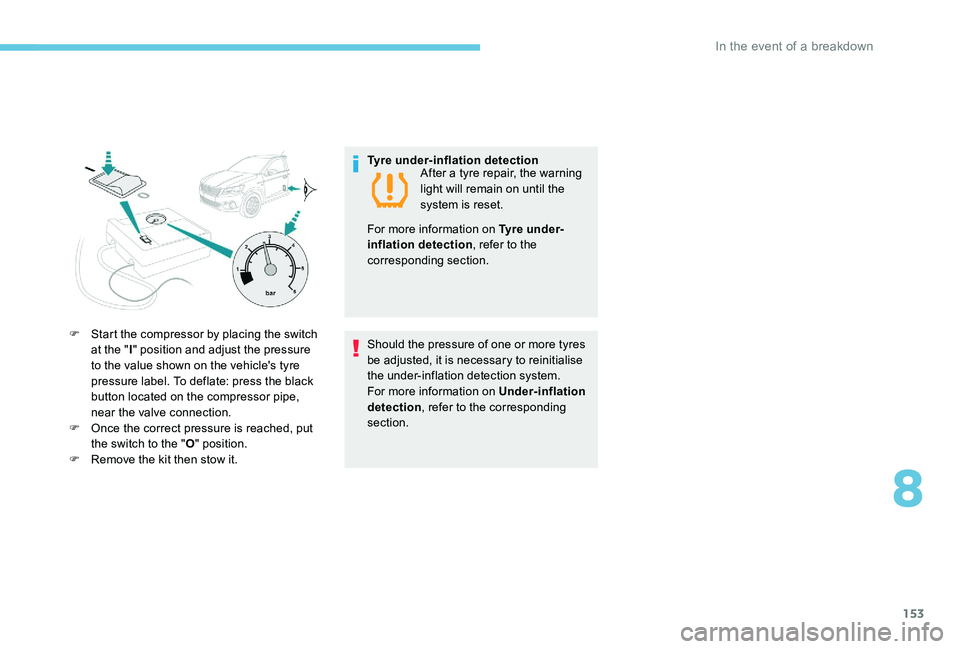
153
F Start the compressor by placing the switch at the " I" position and adjust the pressure
to the value shown on the vehicle's tyre
pressure label. To deflate: press the black
button located on the compressor pipe,
near the valve connection.
F
O
nce the correct pressure is reached, put
the switch to the " O" position.
F
R
emove the kit then stow it. Tyre under-inflation detection
After a tyre repair, the warning
light will remain on until the
system is reset.
For more information on Tyre under-
inflation detection , refer to the
corresponding section.
Should the pressure of one or more tyres
be adjusted, it is necessary to reinitialise
the under-inflation detection system.
For more information on Under-inflation
detection , refer to the corresponding
section.
8
In the event of a breakdown
Page 156 of 306
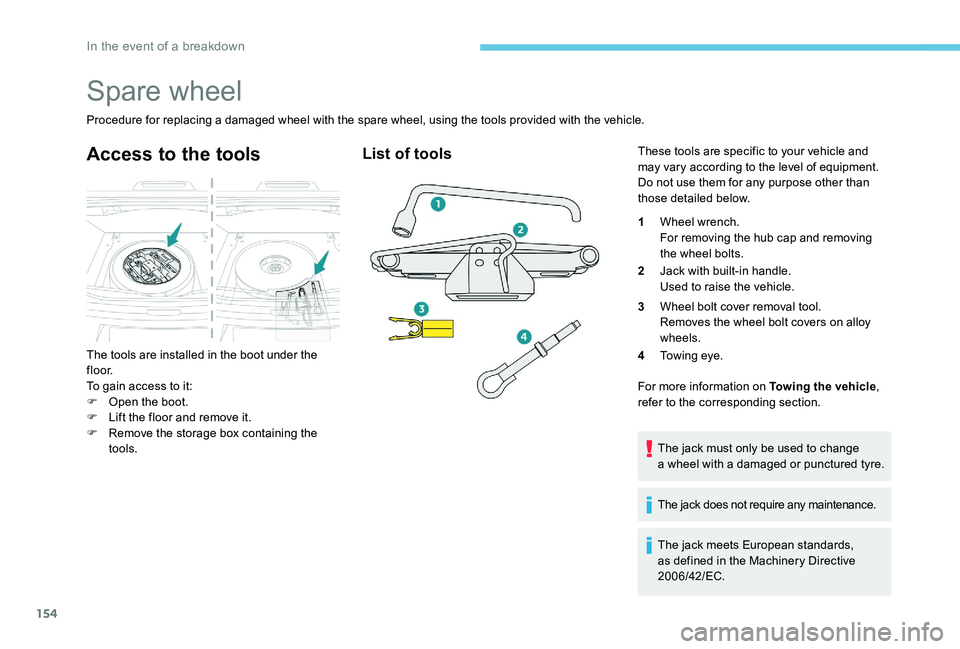
154
Spare wheel
Procedure for replacing a damaged wheel with the spare wheel, using the tools provided with the vehicle.
Access to the tools
The tools are installed in the boot under the
f l o o r.
To gain access to it:
F
O
pen the boot.
F
L
ift the floor and remove it.
F
R
emove the storage box containing the
tools.
List of toolsThese tools are specific to your vehicle and
may vary according to the level of equipment.
Do not use them for any purpose other than
those detailed below.
1 Wheel wrench.
For removing the hub cap and removing
the wheel bolts.
2 Jack with built-in handle.
Used to raise the vehicle.
3 Wheel bolt cover removal tool.
Removes the wheel bolt covers on alloy
wheels.
4 Towing eye.
For more information on Towing the vehicle ,
refer to the corresponding section.
The jack must only be used to change
a wheel with a damaged or punctured tyre.
The jack does not require any maintenance.
The jack meets European standards,
as defined in the Machinery Directive
2006/42/EC.
In the event of a breakdown
Page 157 of 306
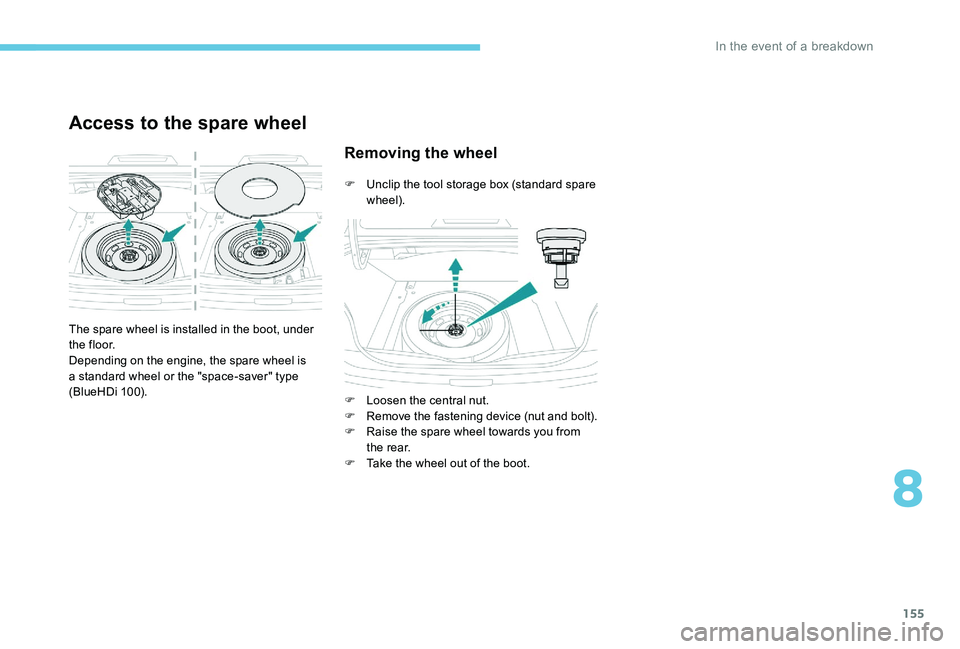
155
Access to the spare wheel
The spare wheel is installed in the boot, under
t h e f l o o r.
Depending on the engine, the spare wheel is
a standard wheel or the "space-saver" type
(BlueHDi 100).
Removing the wheel
F Unclip the tool storage box (standard spare wheel).
F
L
oosen the central nut.
F
R
emove the fastening device (nut and bolt).
F
R
aise the spare wheel towards you from
the rear.
F
T
ake the wheel out of the boot.
8
In the event of a breakdown
Page 158 of 306
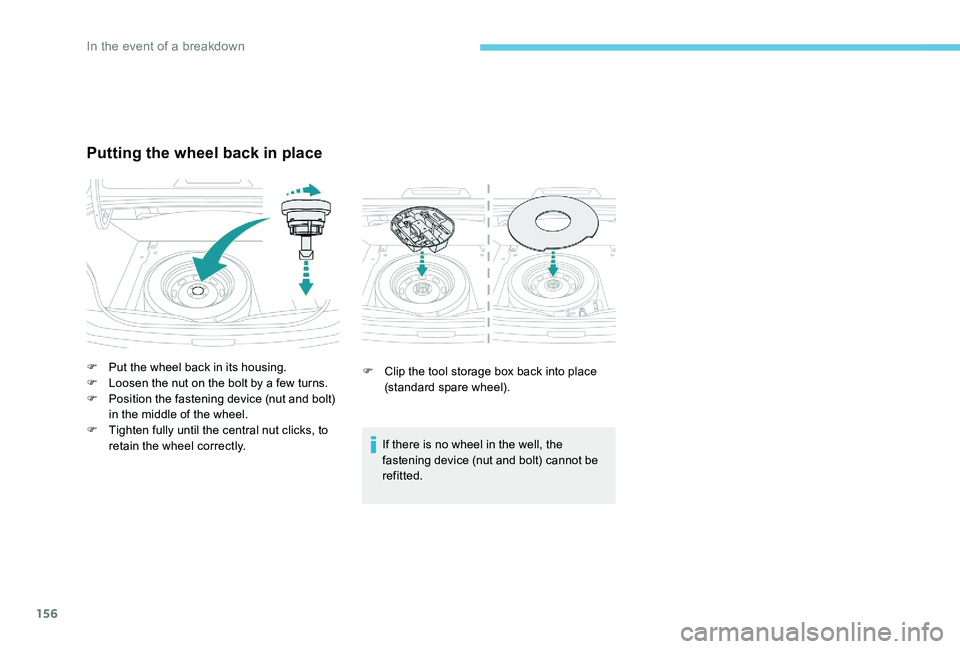
156
F Clip the tool storage box back into place (standard spare wheel).
If there is no wheel in the well, the
fastening device (nut and bolt) cannot be
refitted.
Putting the wheel back in place
F Put the wheel back in its housing.
F L oosen the nut on the bolt by a few turns.
F
P
osition the fastening device (nut and bolt)
in the middle of the wheel.
F
T
ighten fully until the central nut clicks, to
retain the wheel correctly.
In the event of a breakdown
Page 159 of 306
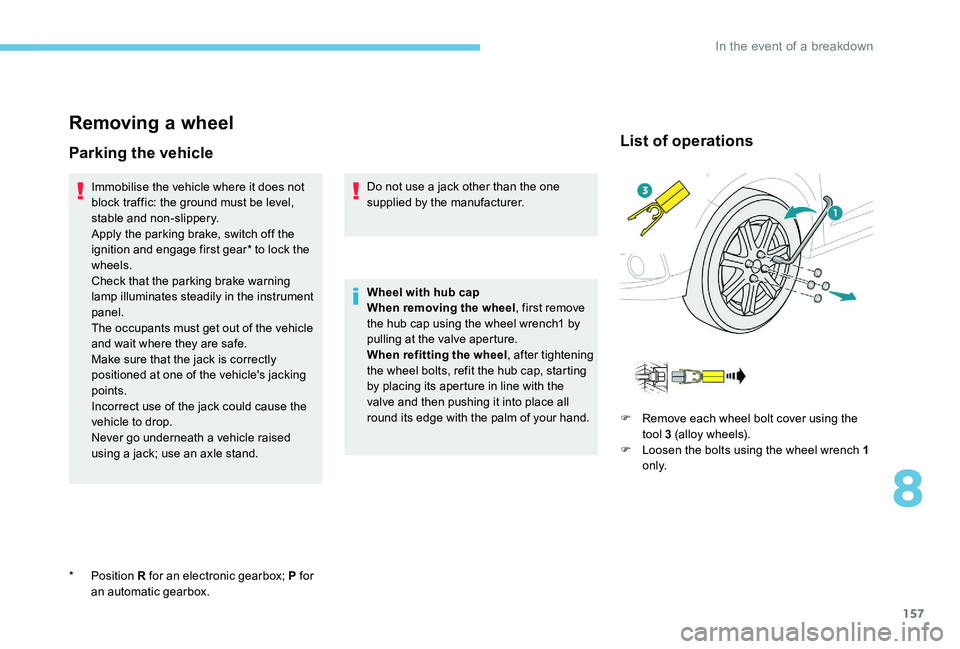
157
Removing a wheel
Parking the vehicle
Immobilise the vehicle where it does not
block traffic: the ground must be level,
stable and non-slippery.
Apply the parking brake, switch off the
ignition and engage first gear* to lock the
wheels.
Check that the parking brake warning
lamp illuminates steadily in the instrument
panel.
The occupants must get out of the vehicle
and wait where they are safe.
Make sure that the jack is correctly
positioned at one of the vehicle's jacking
points.
Incorrect use of the jack could cause the
vehicle to drop.
Never go underneath a vehicle raised
using a jack; use an axle stand.Do not use a jack other than the one
supplied by the manufacturer.
*
Position R for an electronic gearbox; P for
an automatic gearbox. Wheel with hub cap
When removing the wheel
, first remove
the hub cap using the wheel wrench1 by
pulling at the valve aperture.
When refitting the wheel , after tightening
the wheel bolts, refit the hub cap, starting
by placing its aperture in line with the
valve and then pushing it into place all
round its edge with the palm of your hand.
List of operations
F Remove each wheel bolt cover using the tool 3 (alloy wheels).
F
L
oosen the bolts using the wheel wrench 1
o n l y.
8
In the event of a breakdown
Page 160 of 306
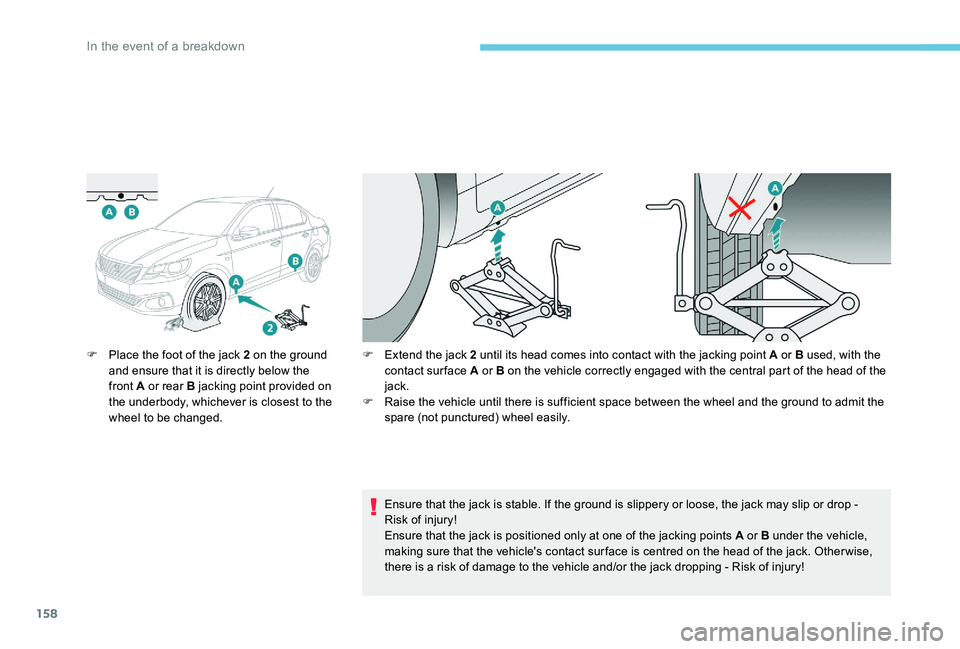
158
F Place the foot of the jack 2 on the ground and ensure that it is directly below the
front A or rear B jacking point provided on
the underbody, whichever is closest to the
wheel to be changed. F
E xtend the jack 2 until its head comes into contact with the jacking point A or B used, with the
contact sur face A or B on the vehicle correctly engaged with the central part of the head of the
jack.
F
R
aise the vehicle until there is sufficient space between the wheel and the ground to admit the
spare (not punctured) wheel easily.
Ensure that the jack is stable. If the ground is slippery or loose, the jack may slip or drop -
Risk of injury!
Ensure that the jack is positioned only at one of the jacking points A or B under the vehicle,
making sure that the vehicle's contact sur face is centred on the head of the jack. Other wise,
there is a risk of damage to the vehicle and/or the jack dropping - Risk of injury!
In the event of a breakdown